

Sullla AGA4: SPGT20 "Fisherman and the Sea"
v.58
Prince Difficulty (China - Mao)
Note: Mao had his original Philosophical / Organized trait pairing for this game, which he would retain until the Warlords expansion shuffled all the leader traits around.
Well, I didn't quite finish this game, but now that another patch is out, it's no doubt better to report what I did come across and move on to another game. Some of the things that I'll try to highlight include religions, wonders, and - of course - AI diplomacy.
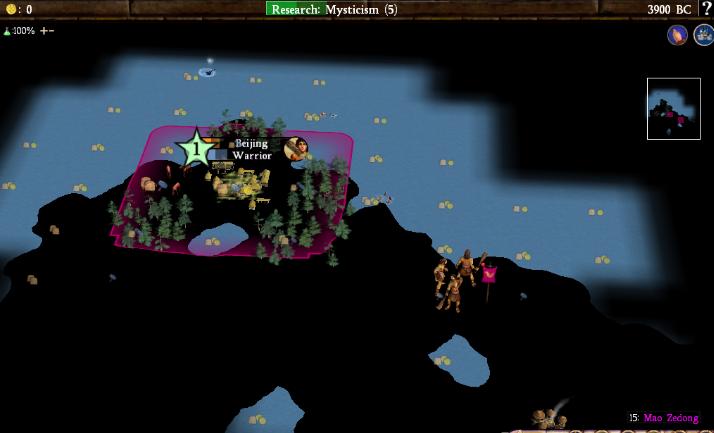
The v.58 build sent me back to the black graphics again, as you can see. There was one difference from what I had experienced before, however: the ocean showed up as blue, as opposed to being also black. Since this map was an archipelago, where almost everything was water, it made the map surprisingly playable after I turned on the food/shields display. Things still weren't exactly easy (I didn't realize that two tiles near the capital were forest HILLS, I thought they were just forest plains), but I made due as best I could.
I'm still new enough to Civ4 that I like founding religions, so I decided to make that my first research path. You can see in the above shot that I started out researching Mysticism, and I planned to go straight from there to Polytheism and take Hinduism. As my warriors examined the starting island, I quickly found that happiness resources were extremely scarce. Plenty of health to be found (crabs, fish, clams, wheat, cows, etc.) but only the incense down in the otherwise useless desert and the whales (useless until Optics) to provide happiness. That made getting to a religion even more important. You can therefore imagine my dismay when Buddhism was taken in 3600BC (the same turn I discovered Mysticism), then Hinduism followed in 3500BC. Yikes. I still had about 10 turns left on Polytheism at this point, so therefore NO chance to get Monotheism first and found Judaism.
This therefore necessitated a new research plan. Immediately when Hinduism was founded in 3500BC, I swapped over to Fishing. I decided to grab the two techs most necessary for this desert starting position (Fishing and Sailing) and then beeline up the top of the tree to Code of Laws and Confucianism. Judaism fell in 2600BC (indeed, I would not have gotten there first).
As for the rest of my civ, I had Beijing build Warrior/Warrior/Work Boat/Work Boat/Worker/Settler out of the gate. Those extra warriors weren't really needed for scouting on this tiny island, but I wanted them for barb duty. Indeed, on this desert island with no forests to hide in, my first two warriors had both been killed by barbs by 2080BC. Ack! The two huts on the island gave me Masonry and gold; nice, but nothing spectacular.
Started researching Code of Laws in 1520BC, and hoped to get there first. After many turns of relatively little action (aside from founding Shanghai, my second city, in 1560BC), I finally discovered Code of Laws in 950BC and did indeed found Confucianism. Shanghai became the holy city, and I used the free missionary to convert Beijing. Here's what my civ looked like around that date:
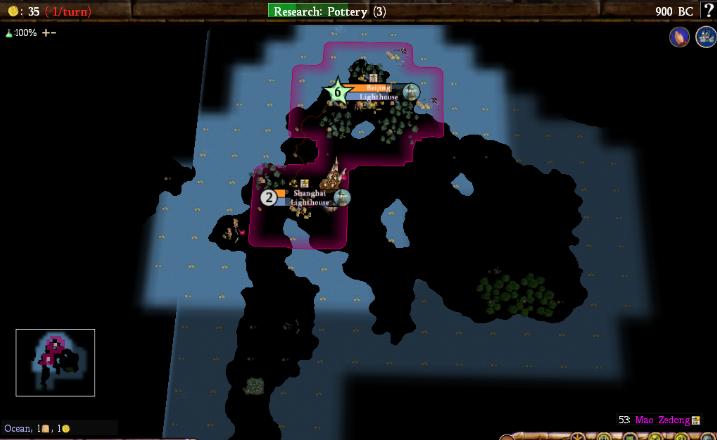
I put Shanghai where I did to try and make the best use of the few non-desert tiles on the starting island. One tile to the west would have been a better spot (and I saw several others put cities there), but it also would have wasted one of the few grassland tiles on the island. Tradeoffs like these are what makes the Civilization games fun. 
As far as religions go, while I saw a number of others complaining in the other threads, I didn't see a problem with the way that the AI acted here. I have no problem with the AI occasionally choosing to go after religions in avid fashion; as long as it does this SOME of the time, in a way that is thoroughly not predictable, I think Civ4 will be stronger for it. I was able to get to Confucianism by pushing after it aggressively and sacrificing pursuit of anything else other than Sailing. Danthrax managed to get to Judaism (how, I don't know!) in his game. Aeson used the Oracle to grab Confucianism. Fried and notyoueither were pursuing non-religious goals and ended up getting left out. Sirian went after Daoism but dropped science spending down quite a bit to get early culture expansions, and also ended up missing it. To me, it seems like the system is working here. Now maybe my opinion is skewed a bit because I was able to get one, but I don't see the need to change anything relating to AI pursuit of religions as long as they only pursue religions aggressively in SOME, but not ALL, games.
Continuing with the story, I realized in 600BC that no one had built the Oracle yet so I made a run after it with Beijing. To my shock, I actually managed to complete it at the very late date of 350BC and used it to grab a second religion for my civ:
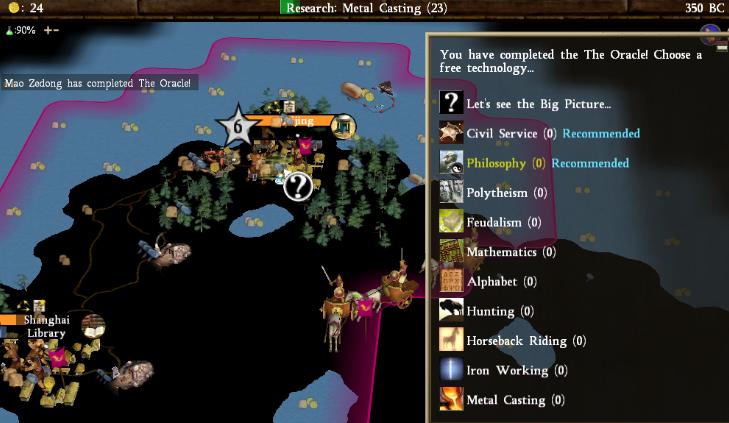
My third city became the Daoist holy city. I again used the free missionary to convert Beijing (that free missionary doesn't make a huge difference, but we may as well leave it in anyway. Perhaps scale it by map size - grant additional missionaries for large/huge maps?) With the help of the Oracle, I expected my first Great Person to be a Prophet, but I had run a few scientists for a few turns in Beijing, and despite a 75% chance for a Prophet, my first GP was a Scientist (125AD). Argh! Well, he became an Academy in the city, so it wasn't all bad. Here is the map from around the BC/AD turnover:
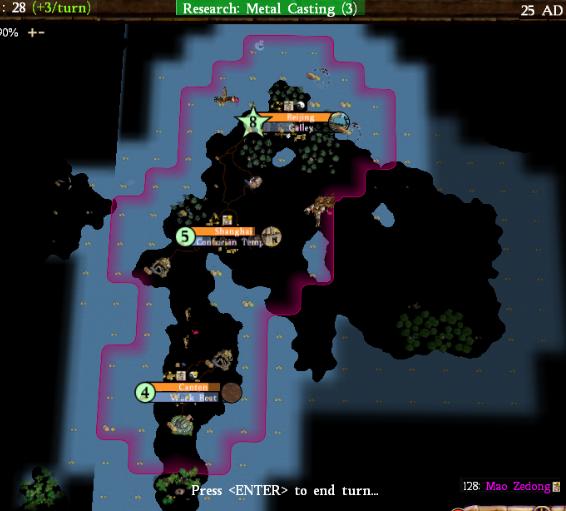
After grabbing my religion with Code of Laws, I paused to grab a couple of outdated early techs and then started beelining for Astronomy. Now, a word of two of explanation about this. You can see I have galleys running around the map here, and I had already found the nearby islands. But, for no apparent reason, I thought that galleys couldn't carry units in Civ4.  I thought that I couldn't move anything off the starting island until reaching Astronomy, aside from Missionaries in caravels. Heh. Another
I thought that I couldn't move anything off the starting island until reaching Astronomy, aside from Missionaries in caravels. Heh. Another  is probably in order for that (even though that isn't a smiley face on these forums). So while Sirian was whipping his civ into a cultural frenzy in order to expand cultural borders to move his galleys across the ocean, I was sitting on my desert rock with these three cities (plus a fourth by the incence, eventually) doing almost NOTHING for literally centuries on end.
is probably in order for that (even though that isn't a smiley face on these forums). So while Sirian was whipping his civ into a cultural frenzy in order to expand cultural borders to move his galleys across the ocean, I was sitting on my desert rock with these three cities (plus a fourth by the incence, eventually) doing almost NOTHING for literally centuries on end.  This is one time I'm glad that the details of these games won't be released to the public, or I would look quite the fool.
This is one time I'm glad that the details of these games won't be released to the public, or I would look quite the fool. 
Ummm, so about that whole not releasing details of these games to the public thing...
One thing I DID do during these early AD years was to build the Colossus in Beijing. (I didn't have the half-cost benefit of that copper on the western island either.) While I didn't take things quite to the level of Fried's game, all I can say is that the wonder is EXTREMELY strong on archipelago maps. I'm not sure whether it needs to be nerfed or not, since in turn it can be all but worthless on pangea maps. At least it now obsoletes (I don't want to think about what it would have been like before that). When combined with a financial civ too - yikes. At the very least, the AI should emphasize building wonders like the Colossus and Great Lighthouse on archipelago maps. Is it possible to write different AI scripting for different map types? The Civ3 AI was notoriously bad at handling archipelago maps, which led to tons of players "gaming the system" by ONLY playing archipelago maps on Deity/Sid. It would be great if we could teach it to play differently on different map settings, at least at the pangea/archipelago extremes.
There's a humorous picture I want to slip in here; just before discovering Astronomy, I realized I could put units in galleys and loaded a chariot into one. I then unloaded the chariot onto the western island - moving across the International Date line in the process. Rather than move one tile west, the animation showed the chariot moving across the ENTIRE WORLD east!
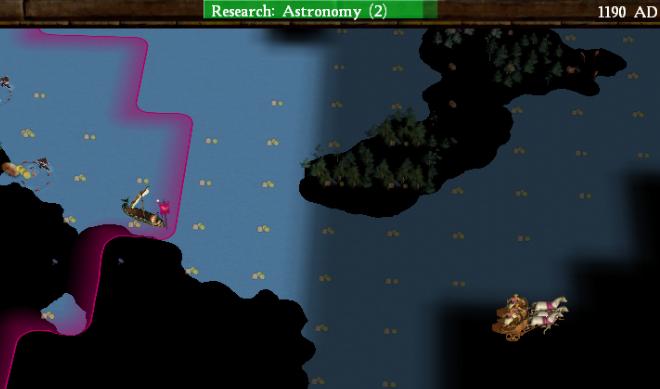
There he goes! Into the unexplored darkness. 
A new era opened in my civ's history in 1200AD when I discovered Astronomy and could start moving my ships (and now units, d'oh!) across the oceans. I immediately founded a city on the western island, which I could have done a thousand years earlier if I had known, and sent some upgraded galleys -> galleons out into the oceans exploring. Found Caesar first to the south and got Open Borders going with him. He eventually converted to Daoism, which spread to his civ naturally. Here is a map from the end of one of my playing sessions, in 1230AD:
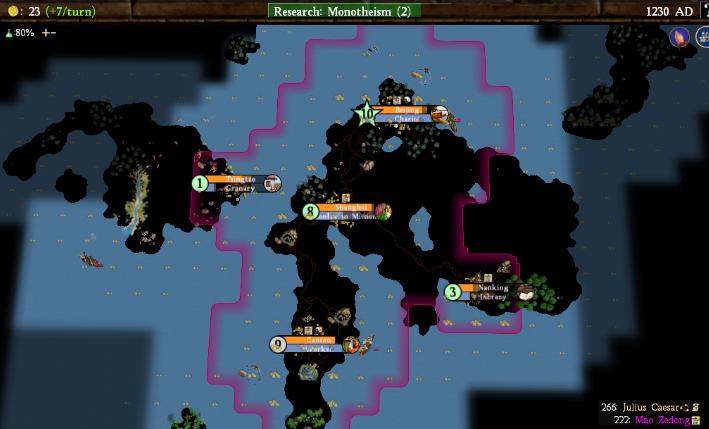
Now, before I started playing again, a partial fix to the black textures problem was posted here on the forums. Let there be light!
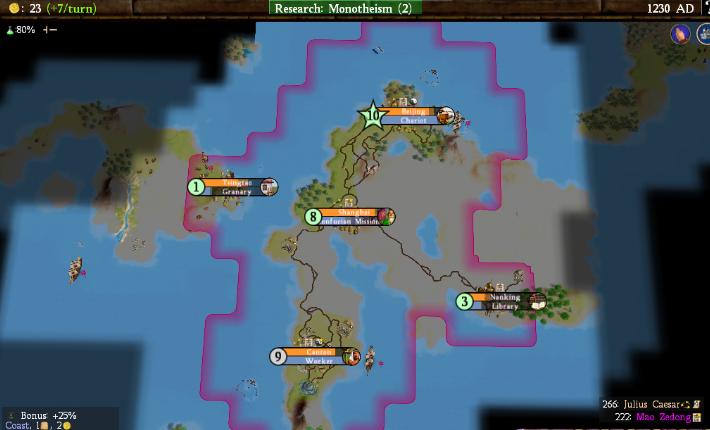
OK, that's still not perfect, but it's a lot more playable. Yet another textures fix was released later and completely solved the problem on my computer, so the rest of my pictures should show up normally. I hope this doesn't come up again; believe me, I've had my fill of playing in the dark! 
My galleons found the other civs pretty quickly, since I had about four of them out scouting. (Wow, was Catherine behind or what?) I appeared to have a monopoly on Astronomy, which I carefully avoided trading to anyone, though I made many deals for other old techs. I converted Catherine to Confucianism with missionaries, and spread some of the religion to Caesar as well. Maybe it was just the draw of the civs, but the AI leaders seemed much more friendly to me in this game compared to SPGT19a. I'm not sure why that was the case, but I was able to get Open Borders with everyone in this game, and to trade for a lot of resources. One thing that did NOT change was civs demanding that I convert to their religion; the incidence was greatly decreased, but it was still happening. I need more information to tell if this is still a problem or not; it didn't happen enough to hurt relations in this game, but it very well could have if more time had passed. I'll see how things are going in the new build before passing judgement.
This next picture shows one area where the AI continues to perform well:
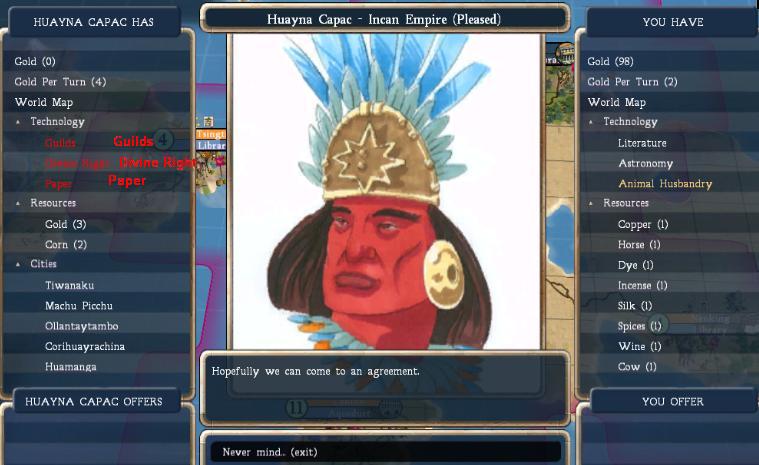
This was taken when I first met Huanya Capac in roughly 1300AD. Notice that he still hasn't researched Animal Husbandry yet - which would appear to be idiotic, except that the Inca had no resources that required it on their homeland. They simply took the other "OR" branch on the tree and kept right on going. At least in this one particular area, the AI clearly understands to skip resource techs it has no use for.
Should there be some kind of a mechanism in place that makes sure that the holy city for a religion goes to a decently strong city? Probably not, but for the later religions on the tech tree, situations like this are going to arise from time to time:
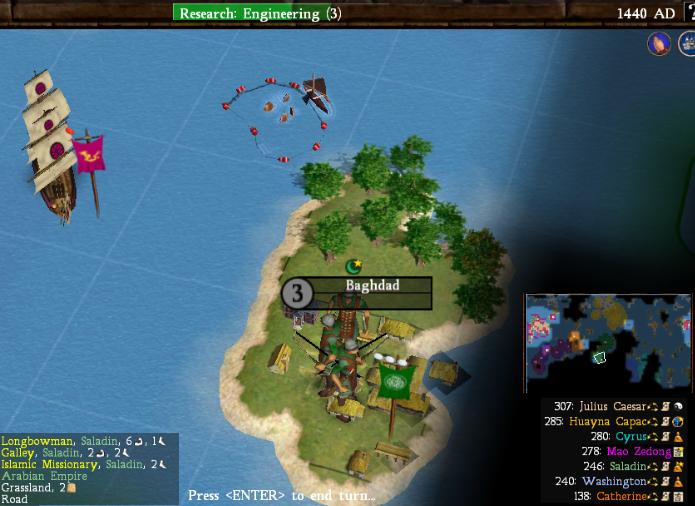
There's the Islamic holy city, a two-tile island off the southern coast of Arabia (and yes, I do like playing around in the free camera mode). That Islamic missionary isn't doing much good there.  (The AI civs were expanding off their starting islands in this game, but only in galleys, not galleons.) The actual city of Baghdad is not that bad, since there are some sea resources near it, but it's not a great location for a holy city. I think any cure for this would be worse than the disease itself, but just bear in mind this IS going to happen from time to time. Then again, the real-world city of Mecca isn't exactly in the most fertile location either.
(The AI civs were expanding off their starting islands in this game, but only in galleys, not galleons.) The actual city of Baghdad is not that bad, since there are some sea resources near it, but it's not a great location for a holy city. I think any cure for this would be worse than the disease itself, but just bear in mind this IS going to happen from time to time. Then again, the real-world city of Mecca isn't exactly in the most fertile location either. 
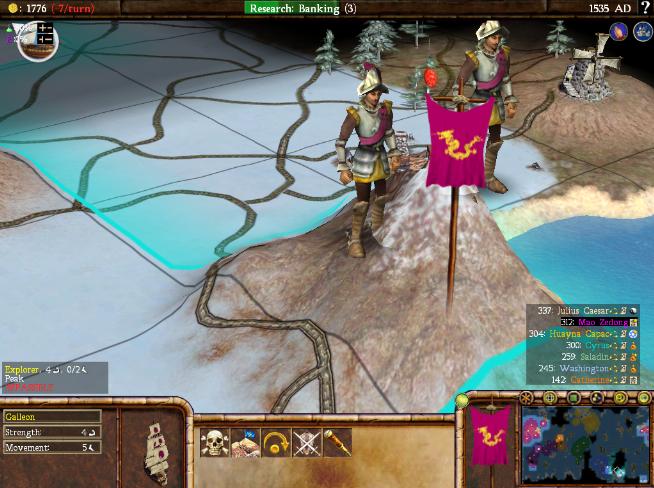
OK, so apparently my explorers are now mountain climbers. Aren't peaks supposed to be impassable? Or is this just a feature of the explorer unit that I didn't know about? If I'm just missing out on a game concept here, feel free to tell me, but that struck me as decidedly odd. In a war, what would happen if these guys camped out on top of a peak? Could anything attack them? I'm confused here.
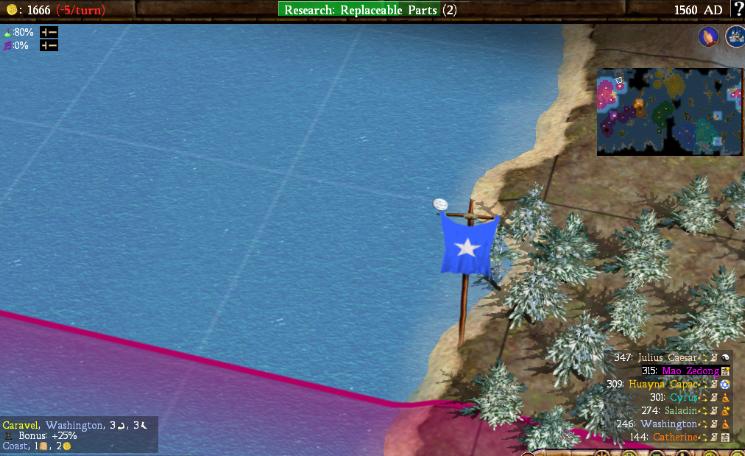
Do you see the American caravel?  Units kept appearing in the wrong tiles all throughout this patch, but for this particular unit, it wasn't on the map AT ALL. Just the flag. I'm sure that this bug is well known and has already been fixed, but this picture was took good to pass up taking. Ditto for the following:
Units kept appearing in the wrong tiles all throughout this patch, but for this particular unit, it wasn't on the map AT ALL. Just the flag. I'm sure that this bug is well known and has already been fixed, but this picture was took good to pass up taking. Ditto for the following:
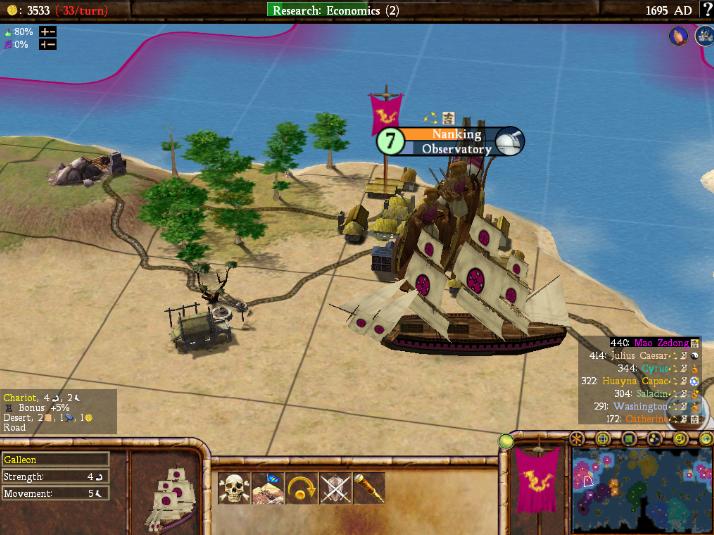
"Sailor, set a course for that incense plantation." "Aye aye, captain!" 
As far as the game goes, I did get a prophet for my second great person and used him to build the Confucian shrine, but my third attempt again failed (despite over 70% odds) and resulted in a merchant instead. As a result, I never built the Daoist shrine, but I did use that merchant for a trade route to Mecca in 1470AD that brought in 1700g. Then my fourth great person was another merchant, who I used for another trade route and 2500g in 1670AD. They let me run science at a fairly substantial deficit without worrying about going broke, so it all worked out.
The other thing I was doing after discovering Astronomy was founding more cities. Lots and lots of cities. Since the AI wasn't doing this with their galleons, they inevitably fell behind me (although I'm pretty sure I could have out-played them on Prince anyway). I made sure to build Chichen Itza in 1570AD and soon was happily cash-rushing my overseas colonies into shape. Sirian was entirely correct when commenting on this; I absolutely LOVE cash-rushing stuff (am not a big fan of pop-rushing and never have been), and I still think that Bureaucracy is an extremely strong civic. Chichen Itza only makes it stronger, so in my last two games that has been an extremely high priority wonder. I see that now it's going to obsolete, which is good, but some more tweaking may still be necessary. We'll see. I still have the feeling that anything other than Bureaucracy is going to become variant material, aside from Police State when war weariness gets too oppressive. But again, time will tell. (To be fair, archipelago maps like this are about the best possible place to run Bureaucracy, but I stand by my comments regardless.)
I had a note on this in AGA3 but it bears repeating here. At the time, Chichen Itza discounted all rushed production by 50%. This was extremely powerful, made more so by the fact that cash-rushing unlocked much earlier at Bureaucracy civic / Civil Service tech. The effect was so powerful that it was eventually moved all the way back to the Kremlin wonder in the late Industrial era.
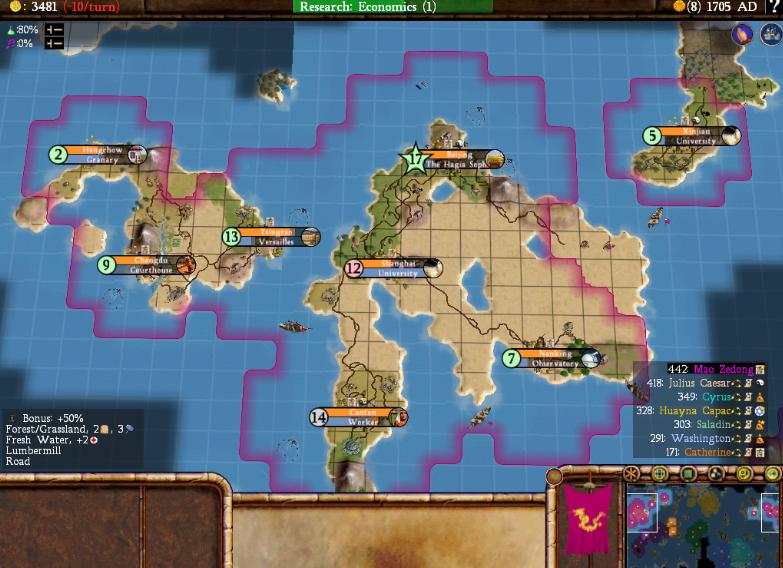
By 1700AD, I was clearly out in first place and expanding my lead. I had just built the Taj Mahal and triggered a golden age, and many of my colonies were starting to come online. The rest of the game would have been mop-up work, so this probably wasn't a bad place to stop. It was a fun game, although an unusual one. I didn't get a great feel for AI diplomacy, mostly because everyone was friendly to me all the time. The AI inability to expand with galleons made this test less useful about halfway through the game anyway. I can't think of anything else to discuss, so I'll just have to stop here.
Oh, and note that my score in 1700AD is roughly the same as Sirian's in 1200AD! That's what happens when you forget how galleys work. 



